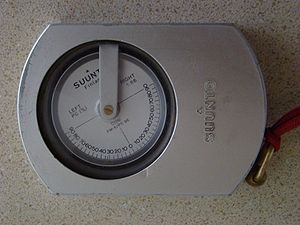Difference between revisions of "AY Honors/Forestry/Answer Key"
| Line 7: | Line 7: | ||
==How It works== | ==How It works== | ||
| − | Clinometers, known in many fields as an "[[inclinometer]]", make use of basic trigonometric principles. Multiplying the [[tangents]] of angles to the base and top of the object and then adding them together gives the observer the total height of the object. | + | Clinometers, known in many fields as an "[[inclinometer]]", make use of basic trigonometric principles. Multiplying the distance (D) between the observer and an object times the [[tangents]] of the angles to the base and to the top of the object and then adding them together gives the observer the total height of the object. |
[[Image:Illustration of the basic trigonometric principles used by a clinometer.JPG|right|thumb]] | [[Image:Illustration of the basic trigonometric principles used by a clinometer.JPG|right|thumb]] | ||
Revision as of 19:01, 1 April 2008
Template:Confusing Template:Internallinks Template:Refimprove Template:Wikify The clinometer is a common tool used in forestry to measure slope, vertical angles, and -incombiation with range measurements- evlevation heights.
How It works
Clinometers, known in many fields as an "inclinometer", make use of basic trigonometric principles. Multiplying the distance (D) between the observer and an object times the tangents of the angles to the base and to the top of the object and then adding them together gives the observer the total height of the object.
Usage
The forester stands at a fixed distance from the base of the tree. The most common distances in the United States are 50, 66, and 100 feet. To obtain accurate readings it is best to use taped measured distance instead of pacing distances. For the most accurate readings it is best to use a distance that is equal to or greater than the height of the tree you are measuring. The observer then sites to the top of tree, if total height is the desired measurement. If merchantable height is the desried measurement the observer sites to a point on the tree where no more merchantable timber can be used. The observer then measures to the bottom of the tree and adds the two figures together. This will be the height of the tree. Always measure a leaning tree so that the tree is leaning to the left or right. Measurements should never be taken with the tree leaning toward or away from the observer because this will affect the accuracy of the measurement. The clinometer is also commonly used by foresters to obtain the percent slope of terrain. This measurement is based on the same trigonometric principles described above.
Manufacturers
Suunto
Haglöf
Brunton
Silva
See Also
References
Avery, T.E. and Burkhart, H.E. “Height Measurement Principles.” Forest Measurements 5th Edition. McGraw-Hill, 2002. 154.

